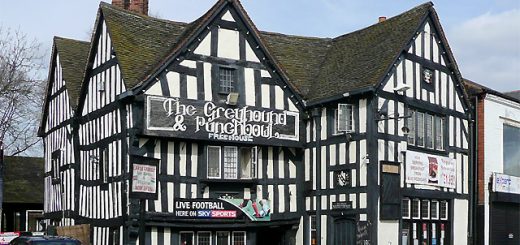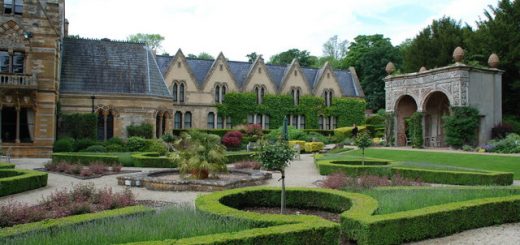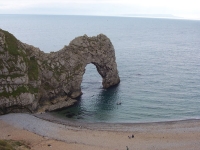The Garricks Head, Bath
The Garrick’s Head at 7-8 St. Johns Place, Bath can be found adjacent to the Theatre Royal and is Grade II listed. It was once one of the homes of the dandy and Master of Ceremonies for Bath, Richard Beau Nash (Born 18 October 1674 – Died 3 February 1761) and has a reputation for being haunted. The Garrick’s website states that ‘Our two resident ghosts have yet to put in an appearance during our time at the pub however there are countless first hand accounts of supernatural happenings.’
![Bin im Garten [CC BY-SA 3.0 (https://creativecommons.org/licenses/by-sa/3.0)], from Wikimedia Commons](http://www.mysteriousbritain.co.uk/wp/wp-content/uploads/2013/06/Bath_Somerset_2010_PD_020-300x276.jpg) The author and investigator Andrew Green (Born 28 July 1927 – Died 21 May 2004) gave the following account of the case: ‘The ghost here is so closely link with the Theatre Royal next door that it is assumed to one and the same, though mysterious knocks and raps and an occasional poltergeist incident associated with the haunting effect only the pub. Establishing that the apparition who visits the theatre is a woman is the ‘scent of beautiful jasmine’, though experienced mysteriously in the cellars. A number of artists appearing in a production at the theatre have witnessed the misty grey shape in one of the boxes, and others have noticed that it travels out of the window in a room just above the main bar. Frequently the smell of jasmine accompanies these ‘visitations’. The phantom is supposed to that of a young woman who jumped to her death in the 1800’s when here lover was killed in a duel with her husband. Another belief, however is that she hanged herself in a bedroom. But why should she frequent this pub, especially it seems the cellar, is an utter mystery. Could it be that the site of the dual was in the pub or perhaps she may be buried beneath the barrels?’
The author and investigator Andrew Green (Born 28 July 1927 – Died 21 May 2004) gave the following account of the case: ‘The ghost here is so closely link with the Theatre Royal next door that it is assumed to one and the same, though mysterious knocks and raps and an occasional poltergeist incident associated with the haunting effect only the pub. Establishing that the apparition who visits the theatre is a woman is the ‘scent of beautiful jasmine’, though experienced mysteriously in the cellars. A number of artists appearing in a production at the theatre have witnessed the misty grey shape in one of the boxes, and others have noticed that it travels out of the window in a room just above the main bar. Frequently the smell of jasmine accompanies these ‘visitations’. The phantom is supposed to that of a young woman who jumped to her death in the 1800’s when here lover was killed in a duel with her husband. Another belief, however is that she hanged herself in a bedroom. But why should she frequent this pub, especially it seems the cellar, is an utter mystery. Could it be that the site of the dual was in the pub or perhaps she may be buried beneath the barrels?’




Re: The Garricks Head, Bath
Beau Nash moved with the help of Juliana Popjoy from the building which is now the Garrick’s Head in 1740. He moved to what is known as Beau Nash House which is very close by. The Strada restaurant can now be found in Beau Nash House and it is also thought to be haunted.
Re: The Garricks Head, Bath
According to Guy Lyon Playfair in his amazing ‘Haunted pub Guide’ (1985)
The ghost-hunter is well catered for in Bath. In 1975 local resident Margaret Royal founded Ghost Walks of Bath, serving as its peripatetic lecturer until her retirement in 1984.
The walks begin, suitably enough, at the Garrick’s Head, one of England’s best-known haunted inns. The building dates from 1720, when it was the private home-cum-gambling club of Beau Nash, after whom one of the present bars is named. During his twenty-year stay there was enough mayhem and sudden death on the premises to lay the foundations of a dozen ghost legends. The most durable one states that a gambler killed his unfaithful wife’s lover, whereupon the woman committed suicide by jumping out of a window.
Nash’s place was connected by a passage to the Theatre Royal next door, and not surprisingly the legends attached to the hotel and the theatre have become somewhat entangled with each other. A Grey Lady has been sighted in a theatre box on a number of occasions, and she is also associated with the pleasant smell of jasmine that has frequently been noticed by members of the hotel staff.
Whether the Grey Lady is the gambler’s unlucky wife is not clear. In any case, it is not for its apparitions that the Garrick’s Head is noted. What makes this case unusual is the variety of well-witnessed phenomena of the poltergeist type. Some experts believe that these normally take place in the presence of certain people rather than in certain places, yet the evidence here suggests otherwise. Phenomena have been reported by a succession of landlords, and they are definitely farther along the mischief scale than those of the Bee Hive mentioned above.
Three independent researchers have recorded detailed testimony from different landlords. From Jack Hallam, pioneer haunted-pub researcher, we have reports of a playful spook who pinched the landlord’s bunch of keys on his very first day’s work, dumping them in the middle of the floor some time later. Then, when the same landlord reached for his mallet to drive a bung into a beer-barrel, the mallet was suddenly not where it just had been — right behind his back. It took him several days to recover it.
Next, Marc Alexander gives us testimony from 1963 landlord Bill Loud, who described how his heavy cash register took off from the bar and crashed into a chair, breaking it to pieces; and from his successor Peter Welch, who saw a pair of candles inexplicably launch themselves from their holders and fly through the air, narrowly missing his wife.
Finally, as Margaret Royal found, this kind of thing went on during the tenancy of Peter Smith, who took over in 1974. A week after he and his wife moved in they were scared out of their wits when a cupboard door began to shake violently for no obvious reason. Then some money went missing from a drawer of a dressing-table, to reappear the next day in an upstairs room that nobody had entered in the meantime. And on no less than four occasions, the refrigerator behind the bar was found to have been switched off at the plug on the wall.